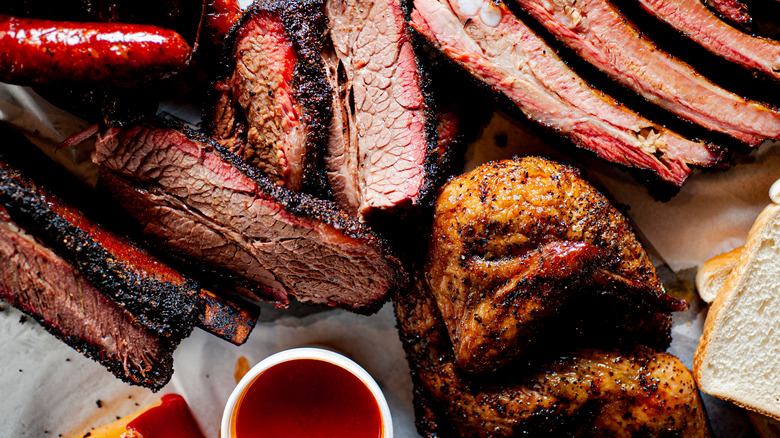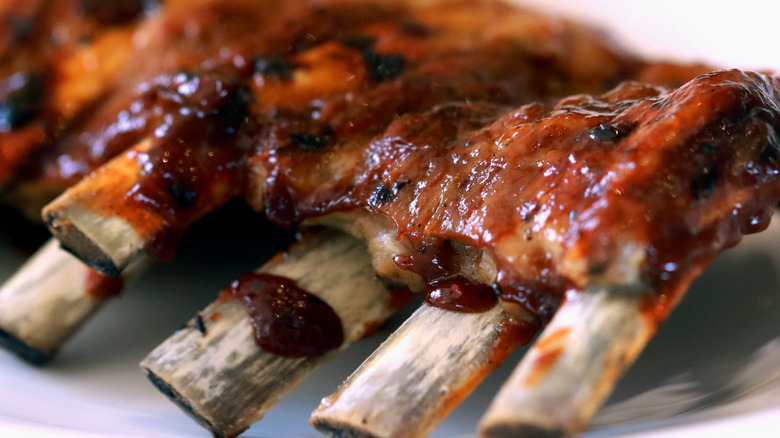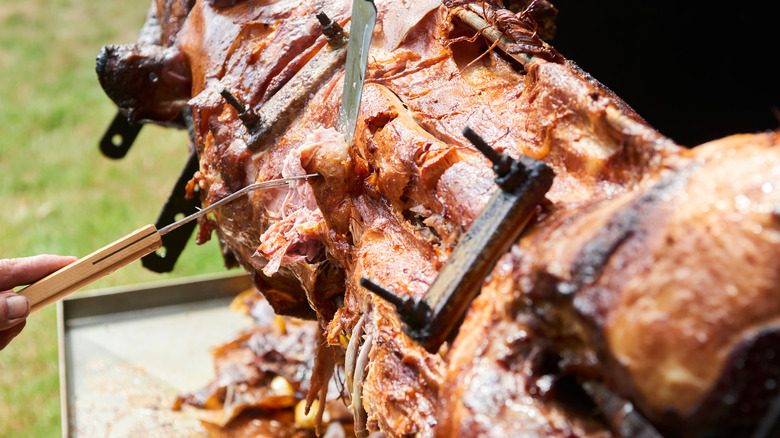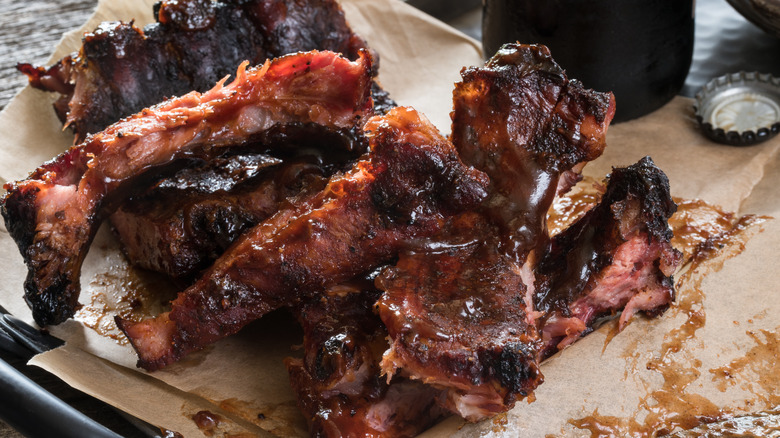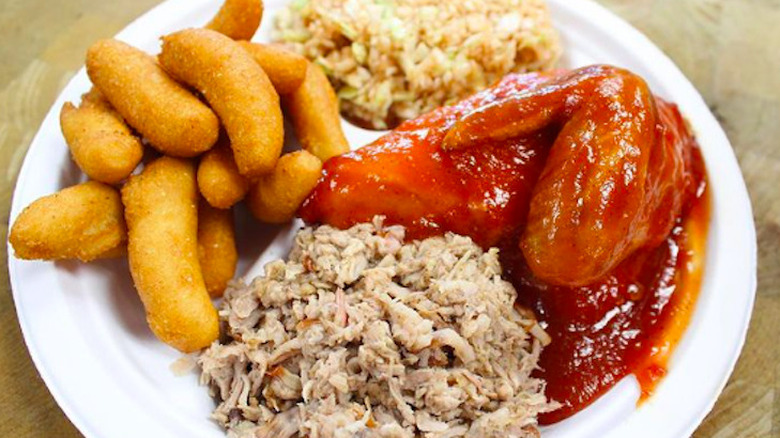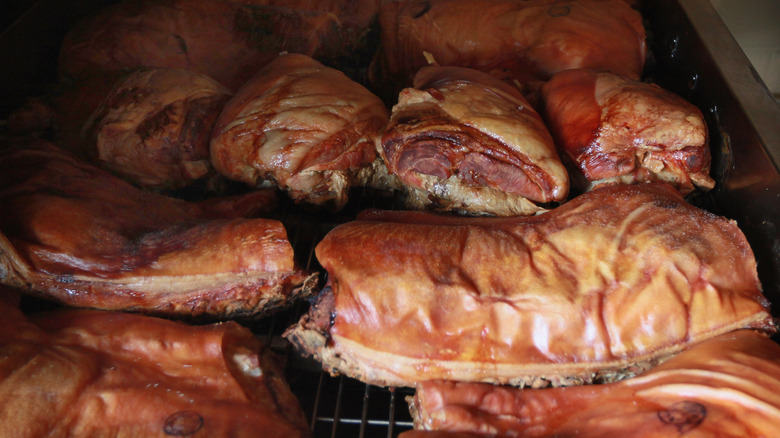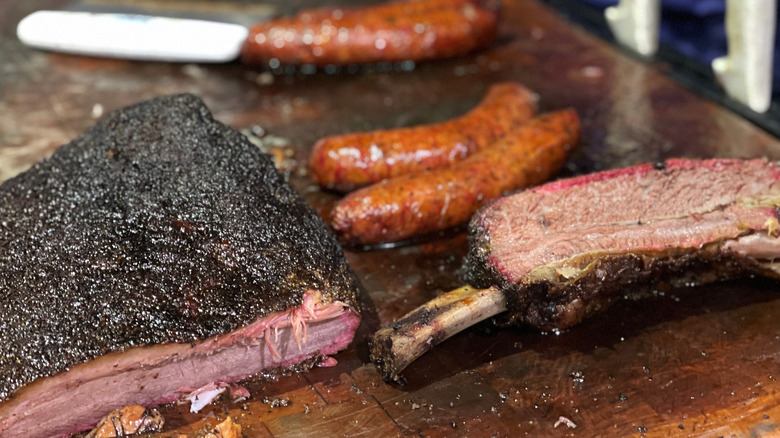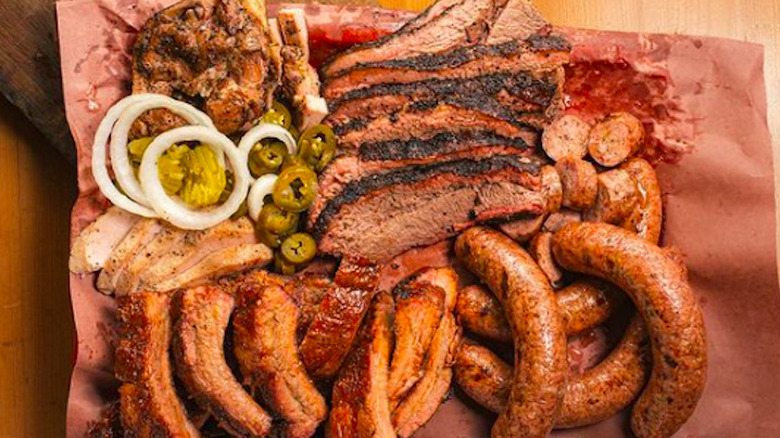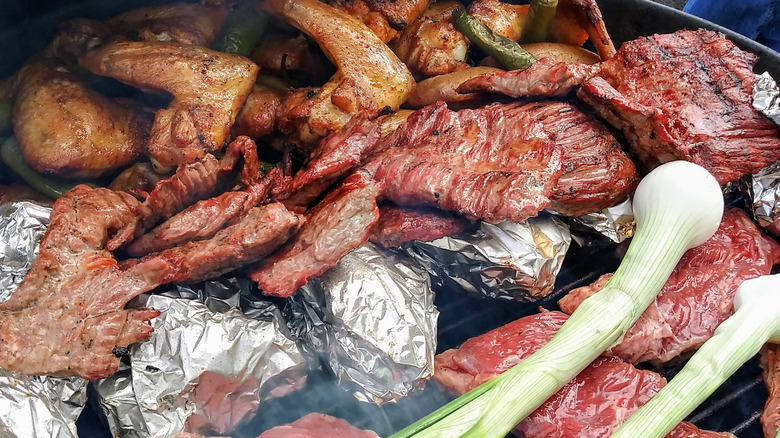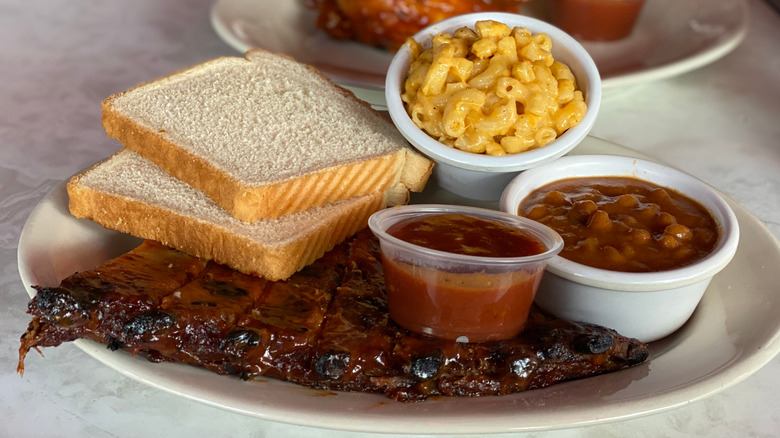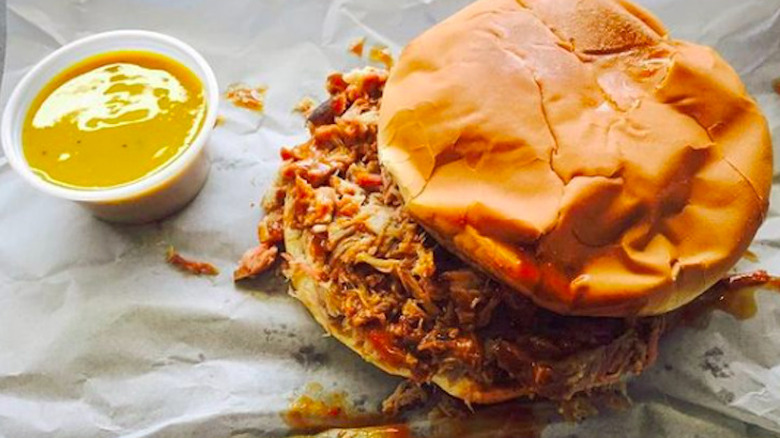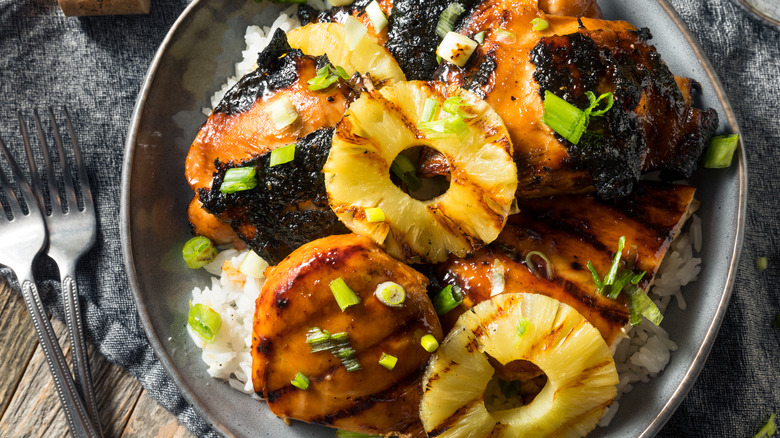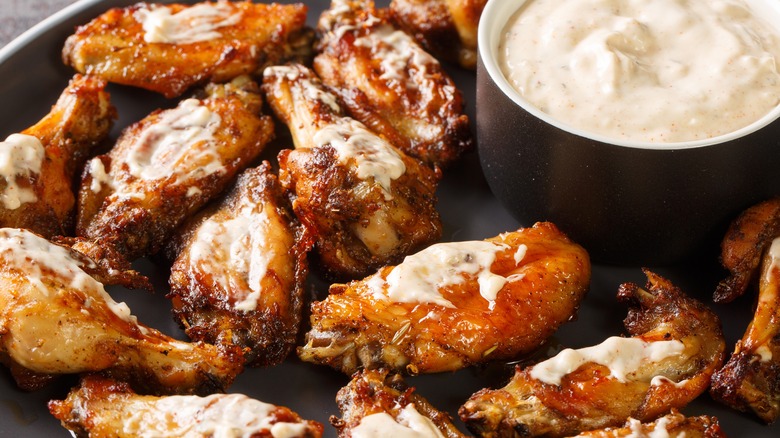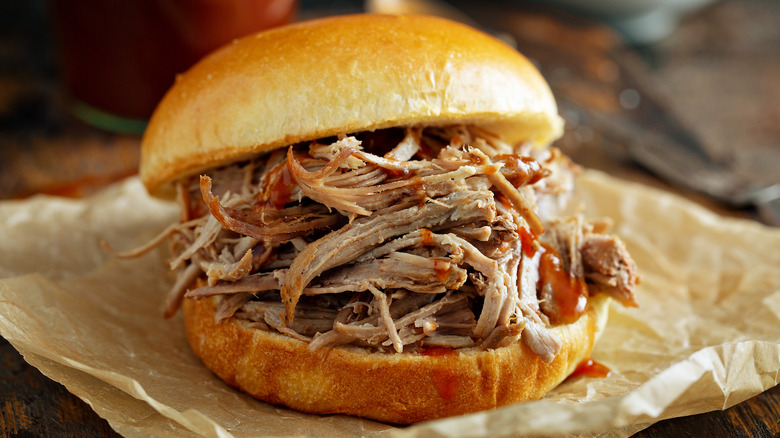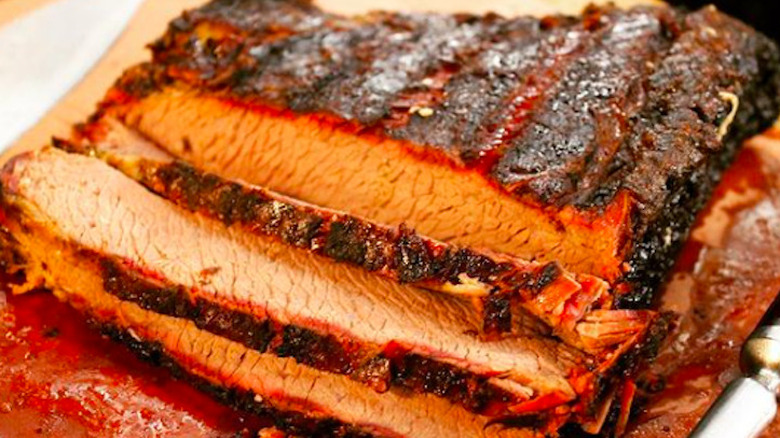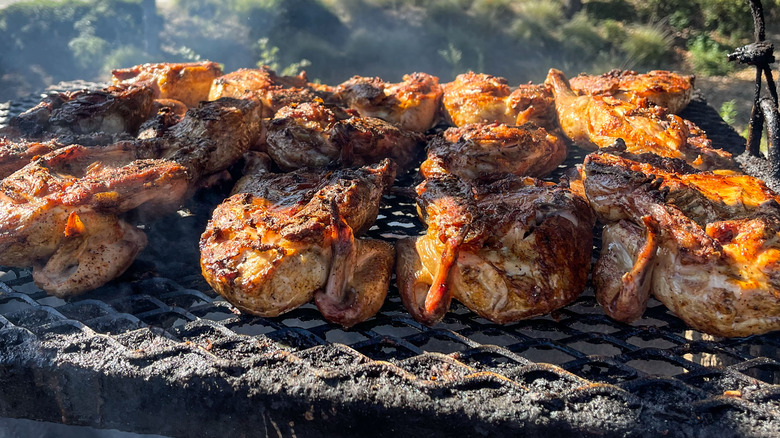Styles Of Regional BBQ In The US
Barbecue is as American as apple pie, and the art of barbecuing is a deeply rooted tradition across many states — from Hawaii to the Carolinas — each with their own techniques, seasonings, sauces, and the types of meat used. The many variations of BBQ in the U.S. speak to our country's history of both colonialism and immigration, though barbecue existed long before America was founded.
Christopher Columbus discovered that the indigenous tribes he met in the Caribbean cooked meat on green wood over an open flame, a technique known as barbacoa, and the explorers who followed in his footsteps brought this cooking method with them to the New World (via Smithsonian). Barbecue's origins have also been traced back to Native American and African tribes who became enslaved or conquered by European colonists, according to Today. The colonists combined their flavor preferences with these centuries-old cooking methods that would spark today's range of regional bbq styles and lead to fierce regional rivalries, generations-old secret recipes, and even pilgrimages to prominent U.S. BBQ sites.
While the most popular areas for barbecue in the U.S. are Texas, Kansas City, the Carolinas, and Memphis, according to a data study by BBQ Revolt, our country is home to many more variations that are worth further exploration. The following regional BBQ styles help to paint a picture of America's vast BBQ landscape, which extends much farther than you may imagine and is deeply embedded into our nation's framework — for better and for worse.
Memphis
Memphis is known for many things: It's the birthplace of rock and roll and home of the blues (along with other genres), Graceland, and historic Beale Street (via Memphis Travel). But foodies know the city best for its incredible barbecue scene. Memphis barbecue is all about pork — shoulders, butts, and ribs — along with pulled pork sandwiches, which dominate the menus at its seemingly endless number of BBQ joints (there are more than 100).
Memphis's unique location on the Mississippi Delta made it an important port town in the U.S., which allowed its residents access to a wide variety of ingredients, from warming spices to flavorful tomatoes and molasses, according to Memphis Travel. This exposure to so many unique ingredients and people from all over the world helped to build the city's rich BBQ culture. But if you're looking to get the recipes for Memphis's legendary BBQ rubs and sauces, you'll have to think again: The Tennessean reports that the alchemies of these joints are so secretive that only a handful of people have been trusted with them over the decades, whether it's the neon yellow mustard-based slaw or smoky, tomato-based BBQ sauce with just the right touch of vinegar. You'll just have to head to Memphis to try some for yourself.
West Tennessee
While Memphis is king of BBQ in The Volunteer State, West Tennessee's rich tradition of whole-hog barbecue should be on every food lover's radar. Renowned pitmaster Pat Martin is at the helm of this dying art, and his new cookbook, "Life of Fire," offers insight into what he refers to as an "endangered species of regional barbecue," plus how to carry on this cherished act yourself. And considering there are only 27 traditional joints left (per BBQ Hub), with six of them being Martin's BBQ locations, this style of BBQ really is in danger of extinction.
West Tennessee's style of whole-hog BBQ used to be part of daily life for those living in rural, small communities in the region (via Texas Monthly). The technique of barbecuing had become prominent in the South, and because pigs were prominent in the area (not to mention cheaper to take care of than cows), this style of barbecue could feed a lot of people for little to no money at all. At Martin's joints, all the meat from the hog gets pulled and mixed with a peppery, acidic sauce that complements the fatty meat, according to the pitmaster, and it's always served with slaw. No part of the animal is wasted here, which speaks to the growing nose-to-tail movement that prioritizes sustainability and ethics in the kitchen (via Le Cordon Bleu). The trend offers hope for the preservation of the West Tennessee style of barbecuing.
Kansas City
Kansas City is a unique BBQ town that's known as a classic place serving up a variety of meats in a signature sweet, thick sauce that's loaded with brown sugar, molasses, and tomatoes. Like Memphis, its location had a major impact on the evolution of its barbecue, as Kansas City was one of the first major boomtowns on the Missouri River in the early 19th century. This made Kansas City a welcome midway point between the livestock breeders in the wild west and consumers on the East Coast (via KC History). However, unlike in Memphis, the barbecue sauce in Kansas City is ultra-thick and even sweeter.
Kansas City's regional BBQ style speaks to the heavy influence of the Black Americans who brought barbecue to the country's culinary vernacular. Henry Perry, known as the father of Kansas City barbecue, began operating out of an all-black, racially segregated neighborhood in the early 1900s where many legendary names in the barbecue world were trained up. His wildly popular cooking methods and recipes were built upon by the next generation of aspiring pitmasters, such as Perry's protege, Arthur Bryant, his brother Charlie Bryant, as well as Ollie Gates, who helped make Kansas City BBQ the widespread obsession that it is today (via KCUR). Arthur Bryant's Barbecue and Gates Bar-B-Q are still local favorites decades later.
Western North Carolina
While North Carolina-style BBQ is one of the most popular regional styles in the U.S., you may not know that there are two main iterations: Eastern style and Western style (also known as Lexington or Piedmont). What makes the Western style stand out is its red barbecue sauce that uses ketchup as a base (per Chad's BBQ). As well, Western Carolina barbecue focuses on pork shoulder, both of which speak to the men of Bavarian heritage who are credited with inventing this fashion of barbecue in the region, according to Outer Banks Coastal Life.
The founders of Western North Carolina barbecue reportedly found inspiration from a beloved Bavarian dish of pork shoulder served with a vinegar-based sweet and sour sauce and likely the advent of ketchup in the U.S. However, you'll find multiple variations across the western half of the state, both sweet and spicy, to suit all taste buds.
Eastern North Carolina
North Carolina's fierce BBQ rivalry rounds out with the Eastern style, which involves smoking a whole pig over a pit with wood coals for at least 12 hours and as long as overnight, then serving it with a peppery, vinegar-based sauce (via NCpedia). This is seen as the original style of Northern Carolina barbecue, as the rift between East and West began during WWI when the group of German pitmasters in Lexington started experimenting with tomato-based sauces and relied solely on pork shoulder — after the Eastern style was developed.
Since Eastern North Carolina BBQ is slow-roasted, involves the whole hog, and is basted with a thin sauce, the meat really gets to shine and offers a totally different dining experience. However, no matter which style of North Carolina barbecue you prefer, it's important to serve it up with hushpuppies, a side of slaw, and a glass of sweet tea, like the locals on both sides of the fence do (via Matador Network).
Central Texas
Texas-style BBQ is another one of the most popular regional varieties listed by BBQ Revolt, but there are actually multiple types of BBQ in the Lonestar State. While there are many styles, Central, East, and South Texas-style BBQ are the most prominent. According to Smoked BBQ Source, Central Texas is where the state's zeal for barbecue began, and is what most people think of when talking about Texas-style BBQ. Beef is simply seasoned with salt and pepper before undergoing low and slow smoking. In fact, you'd be hard-pressed to find an array of sauces and other seasonings on your table to pair with it. The meat is the star of the show in Central Texas, and the sides are just an afterthought — if offered at all.
Gear Patrol says that this style of barbecuing creates perfect alchemy of fatty, charred, sweet meat that has sparked many a smoked meat-fueled road trip in the region (via Texas Monthly). Austin is known not only as the capital of Texas but also as the state's barbecue focal point, so make sure to save plenty of room for local brisket on your next trip.
East Texas
East Texas takes a less holistic approach, but it's one that's equally delicious. You'll often find both beef and pork available on BBQ joint menus in this part of the state, served with a generous array of side dishes. This regional type of BBQ is often served in a sandwich with a thick, sweet, tomato-based sauce that speaks to East Texas's history of being a refuge for newly emancipated slaves in the late 1800s (via The Culture Trip). However, both East and Central Texas do have one thing in common: Both like their meats cooked low and slow over indirect heat, with the eastern side of the state relying on hickory wood to give it that perfectly smoky and succulent quality, according to Masterclass.
While East Texas doesn't have such a clear BBQ capital as Austin, some of the area's charming small towns such as Daingerfield and Marshall are must-see stops for this regional style of BBQ (via Lone Star Travel Guide). These small towns will not only offer some supreme barbecue dishes, but are also sure to serve up a hefty dose of Texas hospitality.
South Texas
While Central Texas is the most heralded BBQ region, the South Texas style is deeply embedded with Mexican cuisine. If you're looking for a historic American BBQ experience, South Texas is a unique place to stop, as it's famous for barbacoa — one of the original methods that came to the U.S. as early as the 1500s, when the Spanish conquistadors that followed Columbus's footsteps.
Unfortunately, South Texas-style barbecue is endangered, as there's only one BBQ joint left in the state (called Vera's Backyard Bar-B-Que) that does it in line with the original traditions, according to Thrillist. This may likely be because the style of BBQ uses some cuts of meat that are unpopular in modern times, such as cow's head, tongue, and diaphragm, as well as goat meat, per Dyer's BBQ. The meats are slowly smoked in underground pits, which also may contribute to its dying presence (via Smoked BBQ Source). You'll often find South Texas BBQ served with guacamole, salsa, and a sweet, molasses-based BBQ sauce, plus other Mexican-style fixings for a truly memorable meal.
Georgia
When you think of Georgia, you may imagine juicy peaches or fresh-from-the-tree pecans, but what about pulled pork? The Southern state actually boasts quite a thriving BBQ scene that's really a way of life. The late journalist Rufus Jarmon once wrote in the Saturday Evening Post that "The barbecue is to Georgia what the clambake is to Rhode Island, what a...canvasback duck [dinner] is to a Marylander, what a Saturday night pork-and-beans supper is to a Bostonian" (via Southern Foodways Alliance).
As in many Southern states, pork reigns supreme as the meat of choice for Georgians, but you'll also find a range of crowd-pleasing favorites served up at many joints such as brisket, smoked sausage, and chopped chicken, which likely speaks to the state's sparkling Southern hospitality (via Eater Atlanta). While you may not find sameness in the sauces and sides, Matt Coggin of D.B.A. Barbecue in Atlanta tells Eater Atlanta that Georgians have a pretty high threshold for smoke, so prepare to feast on some seriously flavorful meat that's likely been smoked overnight. The state's vast interpretation of state BBQ traditions offers a great excuse to hop in the car and take a smoked meat road trip from Augusta to Atlanta and everywhere in between.
South Carolina
Another top regional BBQ style in the U.S., South Carolina is famous for whole-hog smoking and a signature mustard-based sauce that's rooted in the state's rich German heritage. However, CM Library says that the state is known for featuring four main sauces, depending on where you visit: a heavy tomato-based sauce, a lighter version with pepper and vinegar, a strictly vinegar and pepper-based sauce, and the quintessential tangy mustard sauce.
While various parts of South Carolina don't agree on the best sauce for its renowned BBQ, they do agree on slow-roasting whole pigs over a pit or grill rack to achieve that succulent, smokey flavor BBQ lovers lust after (via Wide Open Eats). And while you should try all four sauces if you can, the mustard-based Carolina Gold Sauce will offer the most distinct BBQ eating experience in the Palmetto State, as the other three can be found across the U.S — heavy tomato in Kansas City, light tomato in Memphis, and vinegar and pepper in Central Texas.
Hawaii
Dreams of a Hawaiian vacation may include catching a wave at one of its famed surf spots, hiking to an Instagram-worthy spot, and participating in the state's famous luau culture. Hawaiian kalua pork is the star of the show when it comes to these traditional Hawaiian feasts, but there's so much more to Hawaiian BBQ than a glossy suckling pig and hula dancers. Matthew Gray of Hawaii Food Tours tells the New York Times that the island's BBQ scene speaks to the vast blend of cultures that generously share their cuisines with one another. You may find barbecued "plate lunches" loaded with BBQ pork served up Chinese, Filipino, or Portuguese-style, Korean-style BBQ ribs, or local-favorite Loco Moco — a dish made with hamburger meat, eggs, and gravy (via Cooking the Globe). They'll likely be served with two sides, usually rice and a form of macaroni salad, and don't forget the barbecued seafood!
According to The Manual, Hawaii's deeply embedded BBQ traditions may be the result of its incredible climate that lends to year-round outdoor living, as well as the island's appreciation for meats that lend well to barbecuing over charcoal grills. Dishes like Huli Huli Chicken and barbecued mahi-mahi have found their way to the menus of restaurants all over the world, but there's nothing better than enjoying it as part of an authentic alfresco gathering with the locals who come to share their favorite ingredients and stories for an unforgettable meal.
Alabama
Alabama has become a rising star in the BBQ world in recent years, as cities like Birmingham have become popular food destinations (via Fodor's) and the gospel of Alabama barbecue sauce has been spread beyond state lines. Alabama's biggest distinction from other regional BBQ styles in the South is its thick, white BBQ sauce that's made from a condiment base of mayonnaise, vinegar, salt, and black pepper.
But it's not just the signature white BBQ sauce that distinguishes Alabama's style. Some pitmasters don't simply go by the "low and slow" method — they also source hickory wood chips from local forests for an authentic Alabama smoking experience. And while The Yellowhammer State relies on pork as its prime meat of choice today, that was not always the case. According to AL BBQ History, the state's barbecues featured beef, poultry, and just about any other meat that was available in the mid-19th century, many of which became foods of political and societal change, for better and for worse.
During this time, many pitmasters were Black and most of them were enslaved. Some pitmasters have fought to uphold these early traditions of smoking multiple types of meat over the centuries, and further influence from Greek immigrants has played a major role in establishing the state's BBQ traditions. However, for the classic Alabama BBQ experience as we know it today, a pulled pork sandwich or plate of pork ribs slathered with white BBQ sauce will give you a delicious taste of the state.
Kentucky
A lesser-known regional style of Southern BBQ, Kentucky offers varied takes on this style of cooking from the meats to the sauces and even the smoking methods. Mutton is considered the Bluegrass State's claim to BBQ fame, which is smoked over hickory wood coals and served with a peppery vinegar sauce and a Worchestershire-based dip (via BBQ Hub). However, if mutton's not really your thing, you can find thinly sliced turkey breast and cured ham sandwiches in the west, Boston butts with a buttery, peppery vinegar basting sauce in the south-central region, and shredded pork sandwiches covered in a thick tomato-based sauce near Louisville.
According to Southern Foodways Alliance, Kentuckians have been building the state's BBQ reputation since before the turn of the 19th century and, as in Alabama, became a fixture of political demonstrations across the state. Over the past 130 years, the state's 120 counties have developed myriad forms of Kentucky-style BBQ, with Lexington and Louisville being the true melting pots for various kinds and styles of smoked meat. However, we advise checking out a range of smaller towns to discover the many micro-regions that offer everything from smoked duck to mouth-watering lamb ribs.
Chicago
If Kentucky is a lesser-known barbecue region then the next three are seriously under-the-radar. While Kansas City reigns as the supreme BBQ king of the Midwest U.S., Chicago is a city worth checking out for much more than its hot dogs and deep-dish pizza. Its BBQ tradition reflects The Windy City's diversity and rich history of butchery and immigration. According to NPR, Chicago became a major meat-producing capital once its iconic livestock market, Union Stock Yard, opened to the public in 1865. The publication says this destination transformed the food industry as we know it, popularizing mass production and assembly lines.
During this same time, a mass influx of European immigrants began flocking to Chicago (via PBS), which continued for more than a century and certainly influenced the city's food culture. According to Inside Hook, Chicago takes an Old World approach to BBQ. Each joint reflects its neighborhood and the transplants who have flocked there, but there is some common ground: Many use indoor propane tank smokers or wood-burning ovens in order to keep 'cueing through the city's harsh winters, and ribs are a mainstay of many menus across the city. You'll also likely find that Chicago BBQ joints like their meats rarer than places across the country. The meats are smoked longer than in other regions, pitmasters typically use a wet rub, and a vinegar-based sauce is often served on the side.
Virginia
Hot take alert: there are some BBQ aficionados out there who believe that American BBQ originated in Virginia, many of which are trying to save it from extinction. Virginia BBQ enthusiast Joe Haynes tells the Washington Post that Southern barbecue came from Native Americans living in the region versus from the Caribbean (though he credits African slaves for improving upon the flavor profiles). Founding fathers such as George Washington were even believed to have attended barbecues in the 18th century (via WSJ).
Whether BBQ originated in Virginia or not, the state has a longstanding history of it, which has led to various interpretations depending on the area you're in. Like South Carolina, the commonwealth has four major sauces that are distinguished by the micro-regions of Virginia. Northern Virginia is home to a sweet, aromatic tomato-based sauce, while Central Virginia features sweet and sour sauces that may be spiked with peanut butter or root beer. There's also a vinegary tomato sauce with a hint of mustard in the Southside/Tidewater region, and you'll find herbaceous vinegar sauces in the Shenandoah Valley (via Washington Post). Interestingly, Virginians can agree on one thing: they don't "smoke" meat, they "barbecue." The term smoking is used for sausages, hams, and bacon, according to Southern Grit Magazine.
Central California
Central California is considered one of the best-kept BBQ secrets in America, according to AFAR. This region that's becoming an increasingly popular tourist destination and wine standout is also emerging as a rising BBQ region. You'll find the best of the best in Santa Maria, just outside of San Luis Obispo county (via Sunset), which has a rich history of giant cattle ranches. Like South Texas-style BBQ, Santa Maria has early influences from Mexican cuisine, as well as an impact from Swiss-Italian immigrants that found their way to the region to work on dairy farms.
Santa Maria-style BBQ involves cooking tri-tip beef over locally sourced red oak coals that has been covered with a simple dry rub of salt, pepper, and garlic salt. You'll often find it served with local pinquito beans, while tortillas have since been replaced by garlic bread and pasta. This style of BBQ is often found at local social clubs such as Elks Lodges, but you'll also find variations at local restaurants across the city (via New York Times). Other variations include burritos filled with barbecued meat, giant ribeyes with grilled artichokes, and steaks served with homemade fries.
